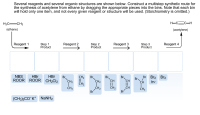
Chemistry
10th Edition
ISBN: 9781305957404
Author: Steven S. Zumdahl, Susan A. Zumdahl, Donald J. DeCoste
Publisher: Cengage Learning
expand_more
expand_more
format_list_bulleted
Concept explainers
Question
Several reagents and several organic structures are shown below. Construct a multistep synthetic route for the synthesis of acetylene from ethane by dragging the appropriate pieces into the bins. Note that each bin will hold only one item, and not every given reagent or structure will be used. (Stoichiometry is omitted.)

Transcribed Image Text:Several reagents and several organic structures are shown below. Construct a multistep synthetic route for
the synthesis of acetylene from ethane by dragging the appropriate pieces into the bins. Note that each bin
will hold only one item, and not every given reagent or structure will be used. (Stoichiometry is omitted.)
H3C-CH3
H-CEC-H
(ethane)
(acetylene)
Reagent 1
Step 1
Product
Reagent 2
Step 2
Product
Reagent 3
Step 3
Product
Reagent 4
NBS
ROOR
HBr
HBr
CH2
||
CH2
Br.
Br.
Br.
Br.
Br
Br2 Br2
ROOR CH2CI2
Br.
CH
CH2
CH
CH
||
CH2
CH2
hv
CH2
Br
CH3
CH
CH3
Br
|(CH3)3CO-K* NANH2
Expert Solution
This question has been solved!
Explore an expertly crafted, step-by-step solution for a thorough understanding of key concepts.
This is a popular solution
Trending nowThis is a popular solution!
Step by stepSolved in 2 steps with 1 images

Knowledge Booster
Learn more about
Need a deep-dive on the concept behind this application? Look no further. Learn more about this topic, chemistry and related others by exploring similar questions and additional content below.Similar questions
- Show the complete mechanism for the following transformation.arrow_forwardcreate a terminal alkyne, predict the product expected upon the completion of a two - step synthetic sequence. ( Include the reagents for each steparrow_forwardneed to check answers; Acetylene is an important synthetic building block that can be used to produce organic compounds with a wide variety of other functional groups. Consider the transformation of 3-phenylpropanal from acetylene shown below, which requires several steps. Part 1; image part 2 : The first step in this synthetic sequence involves an alkyne coupling reaction. Acetylene is deprotonated, and the acetylide anion is reacted with an organic halide. Draw the structure of the halide required in this step. Part 3: imagearrow_forward
- Above each arrow, supply the reagent(s)/reaction conditions that is(are) needed for each of the following (Only one reaction is necessary for each transformation.) transformations. Br SHarrow_forward3. Provide a synthesis of the product (PDT) from the allyl ketoester starting material (SM). No mechanisms needed, but be specific about reagents and conditions for undertaking this multistep synthesis. سلام multistep sequence conditions/reagents مركم PDTarrow_forwardPropose a sequence of synthetic steps that would efficiently accomplish the conversion shown below. You can use any inorganic reagents you like, but the only organic compound you are allowed to use is cyclopentane. multiple stepsarrow_forward
- 6) Draw the major organic product generated in the reaction below. H*, H,0 dilute aqueous acidarrow_forwardCurved arrows are used to illustrate the flow of electrons. Using the provided starting structure, draw the curved electron-pushing arrows for the following reaction or mechanistic steps. Be sure to account for all bond-breaking and bond-making steps. Then draw the organic product of this reaction. Include all lone pairs in the structures. Ignore inorganic byproducts, counterions, and solvents. Incorrect, 2 attempts remaining H & H H Select to Add Arrows H₂O heat H :O: :Br: H H Select to Add Arrows H₂O heat Select to Draw Productarrow_forwardThe synthesis shown above can be accomplished in three steps. Select the reagents for each step from the dropdown lists below.arrow_forward
- 2. Propose a synthesis for the following alkene. You may use any reagents but ethane must be your only source of carbon.arrow_forwardNonearrow_forwardShow the two intermediate structures and final product of the following series of electrophilic aromatic substitution reactions. Show all lone pair electrons.arrow_forward
arrow_back_ios
SEE MORE QUESTIONS
arrow_forward_ios
Recommended textbooks for you
 ChemistryChemistryISBN:9781305957404Author:Steven S. Zumdahl, Susan A. Zumdahl, Donald J. DeCostePublisher:Cengage Learning
ChemistryChemistryISBN:9781305957404Author:Steven S. Zumdahl, Susan A. Zumdahl, Donald J. DeCostePublisher:Cengage Learning ChemistryChemistryISBN:9781259911156Author:Raymond Chang Dr., Jason Overby ProfessorPublisher:McGraw-Hill Education
ChemistryChemistryISBN:9781259911156Author:Raymond Chang Dr., Jason Overby ProfessorPublisher:McGraw-Hill Education Principles of Instrumental AnalysisChemistryISBN:9781305577213Author:Douglas A. Skoog, F. James Holler, Stanley R. CrouchPublisher:Cengage Learning
Principles of Instrumental AnalysisChemistryISBN:9781305577213Author:Douglas A. Skoog, F. James Holler, Stanley R. CrouchPublisher:Cengage Learning Organic ChemistryChemistryISBN:9780078021558Author:Janice Gorzynski Smith Dr.Publisher:McGraw-Hill Education
Organic ChemistryChemistryISBN:9780078021558Author:Janice Gorzynski Smith Dr.Publisher:McGraw-Hill Education Chemistry: Principles and ReactionsChemistryISBN:9781305079373Author:William L. Masterton, Cecile N. HurleyPublisher:Cengage Learning
Chemistry: Principles and ReactionsChemistryISBN:9781305079373Author:William L. Masterton, Cecile N. HurleyPublisher:Cengage Learning Elementary Principles of Chemical Processes, Bind...ChemistryISBN:9781118431221Author:Richard M. Felder, Ronald W. Rousseau, Lisa G. BullardPublisher:WILEY
Elementary Principles of Chemical Processes, Bind...ChemistryISBN:9781118431221Author:Richard M. Felder, Ronald W. Rousseau, Lisa G. BullardPublisher:WILEY

Chemistry
Chemistry
ISBN:9781305957404
Author:Steven S. Zumdahl, Susan A. Zumdahl, Donald J. DeCoste
Publisher:Cengage Learning

Chemistry
Chemistry
ISBN:9781259911156
Author:Raymond Chang Dr., Jason Overby Professor
Publisher:McGraw-Hill Education

Principles of Instrumental Analysis
Chemistry
ISBN:9781305577213
Author:Douglas A. Skoog, F. James Holler, Stanley R. Crouch
Publisher:Cengage Learning

Organic Chemistry
Chemistry
ISBN:9780078021558
Author:Janice Gorzynski Smith Dr.
Publisher:McGraw-Hill Education

Chemistry: Principles and Reactions
Chemistry
ISBN:9781305079373
Author:William L. Masterton, Cecile N. Hurley
Publisher:Cengage Learning

Elementary Principles of Chemical Processes, Bind...
Chemistry
ISBN:9781118431221
Author:Richard M. Felder, Ronald W. Rousseau, Lisa G. Bullard
Publisher:WILEY